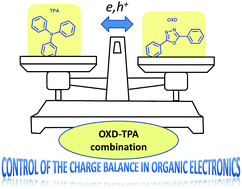Triphenylamines and 1,3,4-oxadiazoles: a versatile combination for controlling the charge balance in organic electronics
Abstract
During the past decade, organic electronics has attracted a great deal of interest due to its applicability in a wide range of applications and high potential for commercial success. These applications notably range from organic light emitting diodes (OLEDs) to organic photovoltaics (OPVs) and sensors. Organic diodes undoubtedly have the potential to redefine many present day lighting solutions if performances and device stability are significantly improved. In these different applications, materials which combine in one molecule a balanced hole and electron transport are currently under intensive research as these materials can ensure an effective exciton recombination or dissociation within the active layer. Over the years, several basic structures have received the attention of researchers for the design of these appealing materials, namely triphenylamines (TPA) and oxadiazoles (OXD) that can respectively act as the hole-transporting and electron-transporting moieties in these ambipolar materials. This review aims at reporting the different OXD–TPA hybrids that have been synthesized to date and to develop a systematic understanding of the structure–property–performance relationships.


 Please wait while we load your content...
Please wait while we load your content...